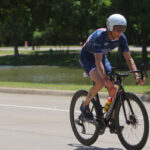Tennis imagery is used by virtually all great players in their training and competitive play. Considerable research has also shown that combining mental imagery with actual practice facilitates learning and improves performance better than practice alone. Tennis imagery is one of the most powerful tools players have to enhance the quality of their competitive preparation and performances because it enables players to develop and integrate all aspects of their game including technique, tactics, and mental skills. Tennis imagery may be used prior to and during the tournament season and can provide mental, physical, and technical benefits. Coaches can make tennis imagery sessions a part of training and help the athletes to develop their own tennis imagery programs. These programs may be organized in team meetings during pre-season training.
Set Imagery Goals
Most players at all levels of tennis use imagery in some way, most typically in the form of daydreaming about their play. Goals are what enables these random imagery experiences to become a valuable part of training. Tennis imagery goals provide purpose and focus to the imagery. Coaches can assist players in deciding what they want to focus on in their tennis imagery. For example, athletes may have a significant technical flaw that needs to be improved. They may want to improve their self-confidence or other mental area. Some component of overall performance may be the emphasis such as being more consistent or aggressive.
In setting these objectives, players should focus performance rather than outcome goals. That is, imagery should address specific areas related to improving the quality of their play rather than on seeing themselves win. Simply put, if players imagine themselves playing well, they are more likely to do their best and winning is the probable result.
Climb Competitive Imagery Ladder
Players must create a competition ladder of tournaments in which they will be competing in the upcoming season. The ladder should start with the least important tournaments and increase through more important tournaments up to the most important tournament in which they will compete. Tennis imagery is then begun at the lowest level of the competitive ladder. Players should stay at that rung until they can reach their tennis imagery goal. When that is achieved, they should stay at that step for several imagery sessions to reinforce positive images, thoughts, and feelings. Players then should work their way up the ladder until they reach their tennis imagery goal at the top of the ladder.
Match-Specific Tennis Imagery
Players should not imagine themselves playing on some court in some match at some tournament. Rather, they should choose a particular tournament and site, e.g., 18s at Kalamazoo. Players can then select a different match for every tennis imagery session, thus reaching their tennis imagery goals on different courts and in varying events and conditions. One thing that must be emphasized to players is that tournaments, sites, and conditions should be appropriate to their competitive levels.
What to Imagine?
Since a tennis match can last up to several hours, it would not be realistic for players to imagine playing an entire match. Rather, they should select 4-5 critical match situations and imagine themselves playing them. For example, key situations might include the opening game, closing out a set, being down a break, and playing a tiebreak. Coaches can help players choose the situations that are most appropriate for their game. For instance, a player might have tendency to let down when ahead or tank when behind. Imagery focused on these situations would enable the player to practice positive responses to them.
Enhancing Tennis Imagery Quality
Total reproduction.
Imagery is more than just mental. It involves players seeing and feeling themselves playing their best. Good imagery should be a total reproduction of the actual tennis experience. It should include all of the thoughts, emotions, and senses (visual, auditory, kinesthetic) that are experienced during an actual match.
Imagine realistic conditions.
It is important that players imagine themselves performing under realistic conditions. That is, if players are not seeded and will be playing on outside courts, they should imagine themselves playing under these conditions. They should only imagine themselves playing under ideal conditions if they are usually seeded and play on the center courts. Players should always do imagery under those conditions in which they normally compete.
Imagine realistic performance.
Players should focus on playing well rather than perfectly in their imagery. For example, junior players imagining themselves playing under tough conditions against a difficult opponent should not see themselves playing flawlessly like a pro. Instead, they should picture themselves playing within their ability and coping well with the difficulties.
Tennis Imagery Sessions
Tennis imagery sessions should be done 3-4 times per week. Tennis imagery should not be done too often because, as with any type of training, players can get burned out on it. A quiet, comfortable area where they will not be disturbed should be set aside. Each session should last about 10 minutes. Players may expect to see some results in 6-8 weeks.
Tennis Imagery Journal
One difficulty with tennis imagery is that, unlike physical or on-court training, the results are not tangible. An effective way to deal with this problem is for players to keep a tennis imagery journal. These logs should record key aspects of every imagery session including the quality of the imagined performance, any thoughts and feelings that occur, problems that emerged, and what they need to work on for the next session. Tennis imagery journals enable players to see progress in their imagery, thereby making it more rewarding.
Tennis Imagery is a Skill
It is important to emphasize that tennis imagery is a skill that, like any other skill, will develop with time. Coaches may find players who can’t seem to imagine themselves playing clearly or they make errors in their imagined performances. Both of these are natural and expected. But if players are patient and put time and effort into an organized tennis imagery program, they will become skilled at imagery in a short time and will gain the many benefits tennis imagery has to offer.



